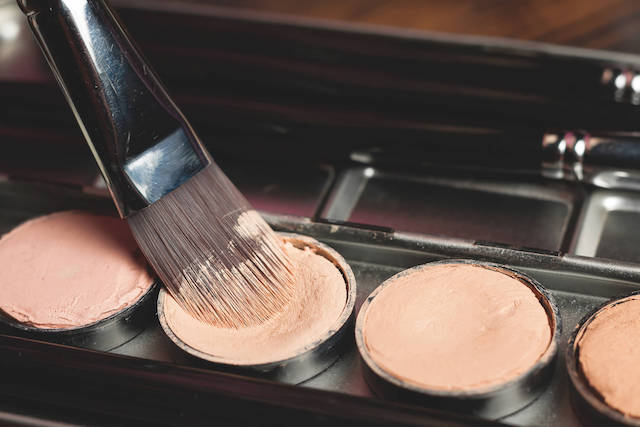Like many products on the market, options abound when it comes to cosmetics. There is a long list of different brands and types of products, not to mention the million and one variations of colors, textures, and ingredient options out there to choose from. All of these products then come together to create a work of art and express the personality of the individual wearing them; it’s pretty amazing when you think about it! While these items are helpful tools for individuality, one thing every user should know is the steps for preventing moldy makeup products.

That way, their beauty routine doesn’t turn into an icky fungus-filled process.
Because no one wants to apply mold to their face. Talk about a skincare nightmare, right? And, to make matters worse, if mold is at the makeup party, chances are that other contaminants like bacteria are also there, causing mayhem.
Actively working on preventing moldy makeup products will not only keep your skin healthy and clear, but will also help ensure your body is happy as well. Eliminating exposure means it’s not battling exposure to these indoor contaminants. It’s a win-win!
That being said, here’s everything you need to know about preventing moldy makeup products, whether you use them yourself or want to make sure your loved one isn’t covered in fungus.
What’s the Deal With Mold?
Before getting into prevention, you need to know about mold. "Know thy enemy," and all that jazz.
Mold 101
Mold actually isn’t the ultimate public enemy number one. This fungus among us plays a huge role in helping nature stay in order by assisting with processes like decomposition. The trouble begins when mold manages to make its way inside of our homes and begins to grow.
Once mold puts down roots called hyphae and starts to thrive, it begins to release microscopic spores into the surrounding area.¹’² Like the seeds of a plant, these spores are non-living particles until they land on a surface that has the components needed for growth. Thanks to its hard nature, mold only needs four main things to start growing.³
These four elements are:
- Oxygen (they need very little, which is why they can grow inside of walls)
- Temperature (40-90°F is preferred, but some species can live in extreme temperatures, which is how mold can grow in refrigerators)
- Food (they eat pretty much everything, like skin cells, wood, and other organic matter)
- Moisture (the often missing puzzle piece)
If these are present on a surface for 24–48 hours, a spore can opportunistically colonize that surface and start the reproductive cycle all over again.
Tying This Into Moldy Makeup Products
Considering those elements listed above, it’s pretty easy to see how moldy makeup products can occur. Temperature? A temperature-controlled home makes this an easy checkmark. Oxygen? Another easy box checked off. That leaves food and moisture.
When it comes to food, edible options abound for a lucky mold spore. Between skin cells, ingredients in makeup products, components of makeup tools, and other random organic matter floating around, there's never a shortage of things a mold spore can eat. That leaves moisture, which can easily become available if products are stored in a humid room or not dried out thoroughly after use.

If a lucky mold spore happens upon this product while it’s buzzing by, it will think that it has won the lottery dream home. Once it has settled in, you’re then dabbing mold spores and particles on your face every time you use that product. Some mold spores also create microscopic toxins called mycotoxins, adding to all of the little particles being spread on the skin.⁴
And, let's not forget bacteria. These particles thrive in the exact same environments and can also make their way onto your face.⁵
Not only can all of these contaminants cause some serious skin issues, but they can also trigger larger health effects as well, which is why avoiding moldy makeup products should always be at the top of your priority list.
Mold, Mycotoxins, and Bacteria, Oh My! (says your body)
In nature, this growth isn’t a problem because all of those tiny little particles have a big, wide world to disperse through. When it occurs indoors or on your makeup products, though, that’s when the situation gets a little messy. Instead of only encountering a few spores, mycotoxins, or bacteria particles throughout the day, now the body is dealing with an entire army of them.

The ability of these particles to cause problems is largely due to their size. Measured in a unit called microns, these tiny specks are invisible to the naked eye and are so small that they can be inhaled, ingested, or absorbed. The EPA further classifies these as particulate matter and breaks them down into two categories.⁶
These two categories are:
- PM10: particles that have a diameter of around 10 micrometers or less.
- PM2.5: fine particles that have a diameter of around 2.5 micrometers or less.
When you’ve got moldy makeup products on your hands (and face), all of this direct contact with the skin ups the ante on how many particles are making their way into the body. As these particles make their way inside, the body tags them as foreign invaders and deploys the immune system to get rid of them ASAP. Again, when it’s only a few throughout the day, this typically doesn’t cause a problem.
When it’s dealing with a huge flood of them, however, the immune system can get overloaded and malfunction.⁷’⁸’⁹’¹⁰’¹¹’¹²’¹³’¹⁴ This opens the door to a slew of negative health effects and conditions like candida, Aspergillosis, and Chronic Fatigue Syndrome.
Some symptoms of exposure include:
- Headaches and migraines
- Brain fog
- Chronic fatigue
- Rashes
- Hair loss
- Skin sensitivities
So, not only could you be dealing with skin issues, but also a host of other problems that make you feel icky and miserable.
The interesting thing about exposure is that no two people respond the same way. While one person may develop an occasional acne problem from using moldy makeup products, another may experience 15 symptoms and an autoimmune condition flare-up. You just never know what the response will be.
Researchers are still attempting to determine how and to what extent exposure can affect health, but it’s a hard subject to nail down. Various factors play a role in how someone will respond to exposure.
Some factors include:
- Species of mold: There are over 100,000 species identified by researchers so far and they have the ability to cause different problems.
- Presence of mycotoxins and/or bacteria: Mycotoxins are naturally toxic to the body, which is why they’re regulated in food products by the FDA, and bacteria can disrupt bodily processes.¹⁵
- Length of exposure: The longer someone is in that toxic environment or using moldy makeup products, the more and more particles are entering the body and the longer the immune system has to fight them off.
- Immune system status: Those with a compromised or developing immune system are at greater risk of experiencing reactions faster and to a greater degree.
- Genetics: Some individuals are less predisposed to fighting off particles like spores and mycotoxins. Research has begun to link those with the HLA-DR as hypersensitive because their body’s immune system does not respond properly to toxins such as mycotoxins.¹⁶’¹⁷
The possibility of developing any health reaction is enough of a reason to actively work on preventing moldy makeup products, and know what to do in case mold or bacteria move in on your cosmetics. Not to mention, once an active mold colony moves into your home, the chances of more colonies developing as it continually releases spores into that indoor space skyrockets.
Preventing Moldy Makeup Products
Avoiding moldy makeup products is all about removing the things needed for them to start growing. In this case, that mainly involves food sources and moisture.
Keep in mind that the more often you use a product, the higher the chance of an issue developing, so pay particular attention to these items.
Here are a few steps you can take to make sure your products are safe for you and your skin.
1. Location, Location, Location
Keep these products out of the bathroom! These moisture-rich rooms are constantly bombarded with water from the shower, sink, toilet, and bath. This can lead to products remaining damp and becoming a perfect little habitat for mold and bacteria.
Instead, opt for a dry, cool area. Mold can grow in high humidity, so aim for maintaining the levels around 35-50 percent.¹⁸

2. Reduce the Moisture
The drier these products are, the less likely they are to become moldy habitats. Steps to keeping them dry include tightly closing products; allowing them to dry out completely after cleaning or use; and storing them in a place with ventilation.
3. Clean Often
Cleaning removes all of those yummy particles that mold and bacteria can eat on the surface as well as any spores or particles that managed to make their way in or on the product. As an added bonus, it also helps with the longevity of the item. With how expensive these items can be, any money saved down the road is a win.
A few quick rules of thumb include:
- Makeup brushes: wash them with a gentle cleanser and hydrogen peroxide at least once a week
- Makeup sponges: wash them with a gentle cleanser and hydrogen peroxide after every use
- Eyelash curler: clean it with hydrogen peroxide once a week
- Pencil sharpener: clean it with hydrogen peroxide after every use
- Tweezers: clean them with hydrogen peroxide after every use
Make sure to allow each item to dry completely before placing it back into storage. A damp item is a moldable item.
When in doubt, ask a product expert for their cleaning and decontaminating suggestions.
4. Stick with the Expiration Date
The older a product is, the more opportunities there are for bacteria and mold to get inside or on the product. Not to mention, older tools have more wear and tear, allowing for more opportunities for moisture to get trapped inside and create a happy little moldy home.
Products should have a date on the back, but there are general rules for keeping them based on the item. Liquid eyeliner, for example, should be tossed out and replaced every three months or so. All tools should have scheduled replacements as well. One example is replacing reusable beauty blenders and makeup sponges at the three-month mark. The "use once and throw away" variety should be used as such, and not recycled.
A good idea is to set reminders on your phone to prompt you when to replace them.
Check with an expert for their tips on when to replace the specific products you use.
How to Deal With Moldy Makeup Products
Unfortunately, the best way to handle moldy makeup products is to get rid of them and replace them with brand new ones. For anyone who is hypersensitive to mold, this is especially important to adhere to.
Once the mold settles inside or on the item, the roots can grow deep within the product or tool, and all of the particles released get blasted all over it as well. You can attempt to decontaminate it and remove those contaminants, but thanks to their small size, it’s almost impossible to ensure they’re all eliminated. Mycotoxins and bacteria are particularly difficult to remove once they have stuck to a surface.

Any particle left behind, whether it be mold, mycotoxins, or bacteria, means that exposure continues and any adverse health reactions will persist. That’s why it’s best to start fresh with a product that isn’t covered in contaminants. Your face and your health will thank you!
How to Tell If Your Makeup Products Are Moldy
Figuring out if you’re dealing with moldy makeup products isn’t always as simple as taking a quick look at your cosmetic arsenal. It involves using the senses for a comprehensive examination to ensure your products are safe for use.
Take a Look
With so many species existing in the world, mold colonies can come in a variety of colors, shapes, and textures. Some of the most common colors include green, white, grey, blue, red, black, brown, or a combination of them. As for textures, they could be fuzzy, powdery, velvety, or slimy.
If any type of growth pops up in or on your makeup products, it's a safe bet to assume there’s a problem.
A good rule of thumb is to assess each product before every use. Mold growth can occur in as little as 24-48 hours, so this contamination nightmare can pop up quickly.
Take a Sniff
Mold growth isn’t always visible. The growth could be occurring below the surface, deep within tools, be blending in with the color of the item, or the colony is too small to be visible just yet. In this instance, look to your nose to help determine if there’s a problem.

Growing mold often creates an earthy, musty, damp smell due to the release of gases called microbial volatile organic compounds (MVOC).¹⁹ If this odor is coming from any makeup products, it points to an issue.
Take a Health Assessment
No visible issues or smells? That still doesn’t mean you’re in the clear because not all mold growth is detectable or creates a stinky smell. In these cases, pay attention to how you feel. If chronic symptoms or skin issues seem to spark up after using the products or continue to develop and no doctor can determine the root cause, it might be from exposure to moldy makeup products.
Our bodies are incredible warning systems that will alert us if something’s wrong, including if there’s a contaminant in our indoor environments. It’s up to us to listen to these signals and figure out what the root cause is so that it can be eliminated.
Any of the indicators above can alert you to a moldy makeup product situation that needs to be dealt with ASAP.
A Healthy Beauty Routine
It can be difficult to find products that you love and that make your skin happy. That’s why it's so important to take care of these items once you find the gems that you swear by. Not to mention, cosmetics are expensive! No one wants to waste money by having to replace moldy makeup products.

Including preventative steps can help ensure that your beauty regime promotes your ongoing health and skincare wellness. That way, you can focus on using these items to create art, try out new techniques, and channel your inner rockstar. There’s no room for mold, mycotoxins, and bacteria to crash your color-packed party.
Health begins at home.™
Citations:
- Environmental Protection Agency. (n.d.). Mold. EPA. Retrieved from https://www.epa.gov/mold.
- Centers for Disease Control and Prevention. Basic facts about mold and dampness. Centers for Disease Control and Prevention. Retrieved from https://www.cdc.gov/mold/faqs.htm.
- Lstiburek, J., Brennan, T., & Yost, N. (2002, January 15). Rr-0208: What you need to know about mold. Building Science Corporation. Retrieved from, https://www.buildingscience.com/documents/reports/rr-0208-what-you-need-to-know-about-mold/view.
- World Health Organization. (n.d.). Mycotoxins. World Health Organization. Retrieved from https://www.who.int/news-room/fact-sheets/detail/mycotoxins.
- Nchh. (n.d.). Mold. NCHH. Retrieved from https://nchh.org/information-and-evidence/learn-about-healthy-housing/health-hazards-prevention-and-solutions/mold/
- EPA. (n.d.). Health and Environmental Effects of Particulate Matter (PM). EPA. Retrieved from https://www.epa.gov/pm-pollution/health-and-environmental-effects-particulate-matter-pm.
- Curtis, L., Lieberman, A., Stark, M., Rea, W., & Vetter, M. (2004). Adverse health effects of indoor molds. Journal of Nutritional & Environmental Medicine, 14(3), 261-274.
- Bush, R. K., Portnoy, J. M., Saxon, A., Terr, A. I., & Wood, R. A. (2006). The medical effects of mold exposure. Journal of Allergy and Clinical Immunology, 117(2), 326-333
- Fisk, W. J., Lei-Gomez, Q., & Mendell, M. J. (2007). Meta-analyses of the associations of respiratory health effects with dampness and mold in homes. Indoor air, 17(4), 284-296.
- Wild, C. P., & Gong, Y. Y. (2010). Mycotoxins and human disease: a largely ignored global health issue. Carcinogenesis, 31(1), 71-82.
- Environmental and Occupational Health Assessment Program, & Environmental and Occupational Health Assessment Program, & Health Science Section, Mold Basics for Primary Care Clinicians (2009). Hartford, CT; Connecticut Department of Public Health. , H. S. S., Mold Basics for Primary Care Clinicians 1–10 (2009). Hartford, CT; Connecticut Department of Public Health.
- Chauhan, B., Santiago, L., Kirschmann, D. A., Hauptfeld, V., Knutsen, A. P., Hutcheson, P. S., ... & Bellone, C. J. (1997). The association of HLA-DR alleles and T cell activation with allergic bronchopulmonary aspergillosis. The Journal of Immunology, 159(8), 4072-4076.
- Knutsen, A. P., Vijay, H. M., Kumar, V., Kariuki, B., Santiago, L. A., Graff, R., ... & Shah, M. R. (2010). Mold‐sensitivity in children with moderate‐severe asthma is associated with HLA‐DR and HLA‐DQ. Allergy, 65(11), 1367-1375.
- EPA. (n.d.). A Brief Guide to Mold, Moisture, and Your Home. EPA. Retrieved from https://www.epa.gov/mold/brief-guide-mold-moisture-and-your-home#tab-6.
- EPA. (n.d.). Should I use bleach to clean up mold? EPA. Retrieved from https://www.epa.gov/mold/should-i-use-bleach-clean-mold.
- Environmental Protection Agency. (n.d.). What does mold smell like? EPA. Retrieved from https://www.epa.gov/mold/what-does-mold-smell.

